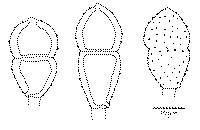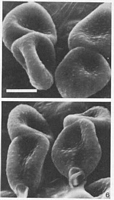|
 Puccinia cruciferarum subsp. inornata Puccinia cruciferarum subsp. inornata
SynonymsPuccinia inornata
BiostatusPresent in region - Indigenous. Endemic
Images (click to enlarge)
Caption: Fig. 5. Puccinia cruciferarum subsp. inornata on Cardamine debilis ex holotype in PDD
(slide as DAR 41553); three teliospores, showing germ pores and warts on spore surface. | 
Caption: Fig. 6. Puccinia cruciferarum subsp. inornata on Cardamine debilis ex holotype in PDD;
SEM of collapsed teliospores showing spore apex (upper)
and spore base (below) and uniform covering of warts. Scale: 8 µ |
Article: Walker, J. (1983). Pacific mycogeography: deficiencies and irregularities in the distribution of plant parasitic fungi. Australian Journal of Botany. Supplement 10: 89-136.
Description: Telia on leaf blades and petioles which are often twisted and slightly swollen, heavily
infected leaves much distorted; telia reddish brown, to 1 mm diam., occurring singly or more
often in clusters up to 2-3 mm diam. on leaf blades or elongated along petioles for 6-7 mm.
Teliospores (Figs 5 and 6) golden brown to reddish brown, 24-37 x 10-14 µm, constricted at
the septum which may sometimes be slightly above the middle, making the basal cell a little
longer than the apical cell, cells of equal width or apical cell sometimes slightly wider; wall
2-2.5 µm thick, finely roughened with very small 0.4-0.7 µm diam. warts, 0.5 µm high and
1.5(-2) µm apart, uniformly scattered over the whole surface of the spore; germ pore apical in
the upper cell, basal and next to the pedicel in the lower cell, both pores covered by a hyaline
papilla up to 2(-2.5) µm high and 4-5 µm wide; pedicel short, usually less than 10 µm long,
sometimes absent, 4-5 µm wide at the hilum. There is a tendency in a small proportion of
spores for the two cells to separate cleanly at the central septum.
Notes: Puccinia cruciferarum is a microcyclic rust lacking pycnia which occurs on several species of
Cardamine in arctic and alpine areas of Europe and North America (especially Canada and
Alaska). It has been studied in detail by Savile (1964), who recognized in the northern
hemisphere collections examined four geographic populations distinguished by the size and
distribution of the warts on the spore wall, the size of the papilla covering the germ pore in
the upper cell of the teliospores and the position of the germ pore in the lower cell. He placed
these populations in four subspecies (see Table 12).
The finding in March 1980 of a rust on Cardamine sp. in the Kosciusko alpine area of New
South Wales represented a new record for Australia of a rust on a member of the family
Brassicaceae and prompted a more detailed investigation of its identity. Comparison with the
description and later with the type and other collections of Puccinia inornata described by
Cunningham (1923, 1931) on two species of Cardamine in New Zealand, showed that the
Australian rust was identical and initially collections were disposed in DAR as P. inornata.
However, a study of Savile's (1964) paper and some northern hemisphere collections of P.
cruciferarum has led to the conclusion that P. inornata would be better considered as a
subspecies (geographic population) of P. cruciferarum, differing from those described by
Savile in the combination of smaller spores, small warts covering the whole outer surface of
the teliospores and a completely depressed germ pore, located at the base of the lower cell
near the pedicel. None of the northern hemisphere subspecies shows this combination of
characters and, in particular, complete depression of the germ pore in the lower cell.
From both the taxonomic and geographic distribution viewpoints, the position of Puccinia
cardamines-cordatae Diet. & Neger described on Cardamine cordata Barn. and C.
reniformis Ph. from the Andes in Chile (Sydow and Sydow 1904; Mujica et al. 1980) is of
considerable interest. No specimens of this rust have been seen during the current
investigation and, from the available descriptions, no firm conclusions about its possible
place in the P. cruciferarum complex can be drawn. In reported spore size (27-37 x 10-15
µm) it is much closer to P. cruciferarum subsp. inornata than to any of the northern
hemisphere subspecies.
Article: Dingley, J.M. (1969). Records of plant diseases in New Zealand. New Zealand Department of Scientific and Industrial Research, Bulletin 192: 298 p. Wellington:.
Notes: Both host species [Cardamine spp.] and rust are endemic to New Zealand. The host plants occur
in subalpine regions of both islands; the rust occurs only in the South Island.
|